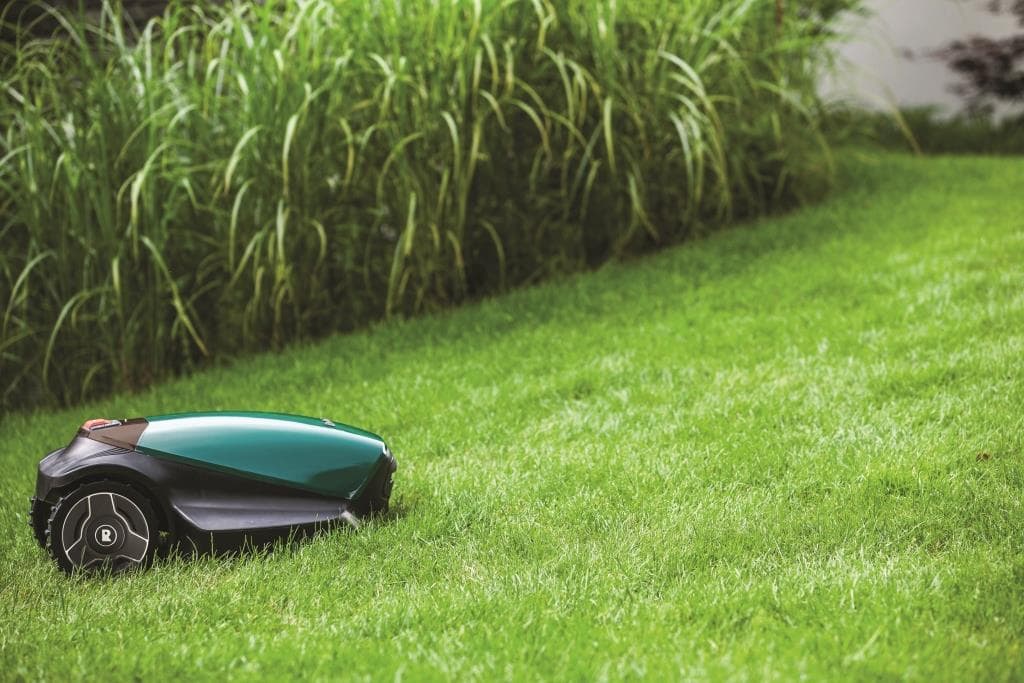Can a robotic lawnmower mow well on uneven, difficult surfaces?
07.05.2021
A robotic lawnmower achieves maximum area output on a simple, optimally rectangular area with zero obstacles to maneuver around; meaning the ground is level and there are no slopes in the terrain. Regardless, this situation is usually found, at best, on sport fields rather than in one's own garden. Therefore, mowing is often much more challenging when terrain structures and special ground conditions are introduced. So, how well does a robotic lawnmower cope with them?
Obstacles in the garden make mowing difficult
There can be a whole range of challenges in the garden that make it difficult for the robotic mower to operate and, in the worst case scenario, can even cause the robot to simply get stuck.
- A slope requires the robotic mower to exert extra effort. Particularly in wet weather, the device is in danger of slipping.
- A lawn is more like a meadow that has been regularly mowed. Otherwise, a meadow has little in common with a perfectly manicured lawn.
- Voles, field mice and gophers dig their tunnels, which collapse causing unevenness to the soil.
- Trees in the garden ensure that small branches and roots create unevenness on the ground.
Features that a robotic mower should have on uneven terrain
In order to be able to respond to these challenges, a robotic mower that is suitable for off-road use should have a number of features.
A good battery capacity
Mowing on uneven terrain requires more power than on a flat surface. It is not uncommon for very hard varieties of lawn to grow. These types can place more demand on a robot than an ornamental English lawn, for example. The same applies to slopes or tall grass that require more energy.
Consequently, it makes sense to look for a device with a powerful Li-Ion battery when buying. The battery capacity is specified in mAh. In rough terrain, values of approx. 3,000 mAh are recommended to ensure that the robot receives the necessary power.
At the same time, to be sure that the mowing process is completed as quickly as possible, the battery should recharge within a short period.
Off-road tires
The more uneven the terrain, the more advantageous it is to have large wheels that can effortlessly maneuver over small holes and depressions. Good traction is also crucial so that the robot does not give way or get stuck on every bump. With a particularly good grip due to coarse tread profiles or spikes, robotic mowers can safely climb or descend slopes when they are damp and slippery.
Maximum cutting heights for meadow-like lawns
It is not uncommon for uneven terrain to be accompanied by a rather robust lawn growth that more resembles a meadow. The grass blades are often several centimeters long and demand quite a bit from the robot. A few robotic mowers really shine when cutting grass that significantly exceeds the otherwise usual 60 mm cutting height and even cut lawns up to 100 mm in length.
Pendulum suspended mowing deck
A bumpy ground or other rough obstacles always result in an irregular cutting pattern that looks messy. The reason for this is a robotic mower whose rigid blades do not follow the ground structure resulting in an uneven cut. The situation is different for robotic mowers with a pendulum-suspended cutting deck. This great construction continuously adapts to the ground surface and produces a clean and even cut everywhere.
Take slopes into account
Not every lawn that is inherently uneven must also have an incline or major slope. However, if that is the case, then it is important to also consider the maximum slope when purchasing a robotic mower. This is often only 20-25% for smaller robots and 45% or more for larger ones.
Sensors for extra safety
On an uneven landscape, the risk of the robotic lawnmower tipping over and exposing the underside is much higher than on a level lawn. It is therefore extremely important to have sensitive lift and tilt sensors that immediately switch off the blade if contact with the ground is lost.
Star blades instead of blade discs
Star blades are more suitable than blade discs, especially if your robotic lawnmower might run over small branches or fallen fruit left on the lawn. These are more robust and easily chop up small hindrances while blade discs tend to break off or become jammed by nuts or twigs.
An apron that is not too low
In principle, a low-lying apron is advantageous so that fallen fruit or other obstacles do not get caught in the blades of the robotic lawnmower. On uneven terrain, however, this proves to be a disadvantage, as the impact sensors may be triggered too early. It also increases the risk that the robot will simply get stuck. Instead, a slightly higher apron is helpful.
Certainly, not every robotic mower delivers perfect cutting results on uneven terrain. It definitely requires some special features for a robot to work its way safely through a rather bumpy garden - and also achieve perfect cutting results. However, if these are given, there is absolutely nothing to be said against using a robot.
Products
Buy a Robomow
Robomow owner
About us
Sales & Support

